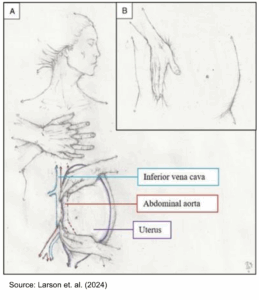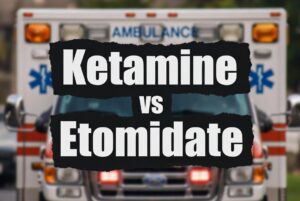by Carly Loner, MD
Case Scenario:
EMS is called to the scene of a motorcycle accident involving a 42 year old male. The patient was helmeted and his head is atraumatic, but he is confused. Breath sounds are equal bilaterally. The patient’s abdomen is diffusely tender and he has an open left femur fracture that is bleeding profusely. A tourniquet is applied to the left proximal thigh with control of active bleeding and a pelvic binder is placed. Initial vitals are HR 132, BP 85/60, RR 28. The patient is loaded into the ambulance and they depart towards the Level One trauma center 35 minutes away. The ground team does not carry blood, but they have been considering adding TXA for situations such as this…
Literature Review:

Tranexamic acid (TXA) is a synthetic analog of the amino acid lysine that stabilizes clot formation by binding to lysine receptor sites on plasmin, thus preventing it from binding to and degrading fibrin. It has been used in the medical arena for many years for the treatment of bleeding. TXA is approved by the US Food and Drug Administration (FDA) only for use in heavy menstrual bleeding and for patients with hemophilia undergoing procedures, but it has a long history of off label use in the elective surgery setting [1]. More recently, it has been utilized as a therapy for the prevention and treatment of hemorrhagic shock. TXA use to treat traumatic hemorrhagic shock became more widespread following publication of the Clinical Randomization of an Antifibrinolytic in Significant Hemorrhage-2 (CRASH-2) trial [2]. This study showed that administration of TXA within 3 hours of injury reduced mortality, but had increased mortality if given after the 3 hours time-point. The results of CRASH-2 were substantiated by the military application of tranexamic acid in trauma emergency resuscitation (MATTERs) study. This retrospective study of a UK combat hospital found that subjects (combat casualties receiving 1 L or more of RBCs) had improved survival due to TXA versus placebo, and this benefit was increased in patients requiring massive transfusion [3]. Another study by Gayet-Ageron et al. sought to quantify the effects of treatment delay on TXA. Simulated models determined that the benefit of TXA decreased by 10% for every 15 min of treatment delay until the 3 hour mark, after which there was no longer a benefit of TXA administration [4]. The literature supporting the use of TXA has continued to develop and the Department of Defense’s Committee on Tactical Combat Casualty Care (CoTCCC), American college of Surgeons Committee on Trauma, European Task Force for Advance bleeding Care in Trauma all recommend administering TXA to hospitalized trauma patients as soon as possible [5, 6].
The time-dependent benefit for TXA may be due to the pathophysiology of trauma-induced coagulopathy. Massive bleeding within trauma patients has been shown to have distinct phases. The fibrinolytic phase shows these patient are prone to acute blood loss not only from hypovolemia but also from coagulopathy resulting from acidemia, hypothermia, shock, and hemodilution [1]. The coagulation cascade is activated immediately after a trauma with increased tissue factor and thrombin production and activation [1]. Tissue hypoxia due to hemorrhagic shock causes release of tissue-plasminogen factor [1]. The early phase of response to trauma is a fibrinolytic coagulopathy and studies have shown that this is where TXA may be most beneficial [2-4]. If given at a later stage of post-trauma coagulopathy, the fibrinolytic shut-down phase, TXA could enhance the pro-thrombotic state and increase multi-organ dysfunction secondary to vascular microvascular occlusion [1, 11]. The coagulation/fibrinolysis states of the patient may be important for determining benefit versus detriment of administering TXA.
There are multiple mechanisms by which TXA is thought to contribute to improved outcomes in trauma patients. In addition to its anti-fibrinolytic role in preventing fibrin breakdown, TXA prevents trauma- induced coagulopathy by preserving the endothelial glycocalyx and thereby reducing vascular permeability and intervascular hypovolemia contributing to shock [1,6,7]. TXA also has anti-inflammatory effects that reduces post-ischemic neutropenic and mast cell activation which protects lung tissue, reduces vasopressor requirements, and reduces chest tube output [8-10].
However, prehospital TXA administration remains controversial.
On the positive side, TXA administration has a time-dependent effect on mortality reduction: a post-hoc analysis of the CRASH-2 data suggests that the mortality benefit is achieved by administration within one hour of injury [12]. Several studies have found benefits of prehospital TXA administration. A UK prospective analysis studied the effects of prehospital administration of 1 g TXA in patients with concern of hemorrhagic shock. This study found that reduced multi-organ failure (OR 0.27, 95% CI 0.10 – 0.73) and reduced mortality (OR 0.16, 95% CI 0.03 – 0.86) in patients with shock when TXA was given by prehospital providers [13]. A more recent retrospective, propensity-matched German study of trauma patients transported by helicopter found significantly reduced 24 hr mortality (5.8 % with TXA vs. 12.4 % without TXA), but no significant difference in overall mortality (14.7% with TXA vs. 16.3 % without). TXA was found to prolong time to death (8.8 +/- 13.4 days vs. 3.6 +/- 4 days) [14]. Preliminary evidence from the Cal-Pat Study suggests a non-significant trend towards decreased 24 hr, 48 hr and 28 day mortality in patients receiving prehospital TXA [15]. In Israel, TXA is given at the point of injury in both civilian and military settings [16]. In the pediatric population, Eckert et al. studied the effects of TXA in pediatric patients injured in a combat setting in Afghanistan and found reduced mortality [18]. Multiple studies of prehospital TXA use in trauma are ongoing, including the Study of TXA During Air and Ground Medical Prehospital Transport Trial (STAAMP Trial) is a US multicenter randomized control trial investigating TXA on US Helicopter EMS services and is expected to be completed in March 2018 [17].
On the opposite side, TXA use is associated with side effects induce GI pain, joint pain, fatigue, visual disturbances, and of greatest concern, thromboembolic events. However, the CRASH-2 trial found no significant difference in vascular occlusive events between TXA group and controls, but did contribute thromboembolic events with delayed administration during fibrinolytic shut down phase [2]. Multiple other studies have found no significant increase in occurrence of thromboembolic events [4, 15]. However, in the UK prospective analysis, while favorable of TXA administration did find 4-fold increase of thromboembolic events in the shock group which received TXA [13]. TXA has not been found to increase thromboembolic events in the elective setting and thromboembolic events in the setting of trauma may be due to additional factors such as stasis and surgery [3].
Given concern for increased coagulopathy and incidence of multi-organ failure if TXA is administered during the fibrinolytic shutdown phase, some argue that TXA should be withheld until coagulation testing can be done which demonstrates hyperfibrinolysis [5,19]. However, awaiting for this testing delays time to administration and puts patients closer to the fibrinolytic shut down phase of trauma- induced coagulopathy. A study by Stein et al. compared coagulation studies both on scene and upon arrival to the hospital between patients administered TXA versus placebo. On-scene samples showed no significant difference but coagulation studies of the TXA group on hospital arrival demonstrated reduced hyperfibrinolysis and preserved fibrinogen levels [20].
A 2017 review of the literature of prehospital TXA administration recommends an intermediate approach where the 1 g initial bolus of TXA is given in the field with further administration of TXA only given after coagulation testing at the hospital demonstrates continued hyperfibrinolysis [6]. There is no current evidence to support this two-step approach, bringing up the ever-important point that prehospital and in-hospital trauma care are two points on the same continuum. Regardless of location, prehospital implementation of a TXA protocol requires a collaborative effort with hospital emergency department and trauma services to ensure that care that is initiated is continued.
Take Home: The use of TXA within trauma is controversial and still developing as literature expands. However, studies do indicate that there is greater benefit to early administration of TXA versus delayed administration. The negative effects of TXA may also be decreased if given early in the course of hemorrhagic shock. There is growing evidence demonstrating reduced morbidity and mortality with prehospital TXA administration. The role of TXA will likely continue to expand and it has potential to be employed in the prehospital setting to improve survival of patients in hemorrhagic shock.
EMS MEd Editors Maia Dorsett, MD PhD (@maiadorsett) & Jeremiah Escajeda (@jerescajeda)

Additional Resources:
Current clinical prehospital trials of TXA use in Trauma at ClinicalTrials.gov
Enthusiasm for prehospital TXA use may be premature (JEMS)
Tranexamic acid\’s potentially bright future relies on collaborative data (JEMS)
Trending: More EMS Agencies administering TXA (EMS1)
References
1. Nishida, T., T. Kinoshita, and K. Yamakawa, Tranexamic acid and trauma-induced coagulopathy. J Intensive Care, 2017. 5: p. 5.
2. Roberts, I., et al., The CRASH-2 trial: a randomised controlled trial and economic evaluation of the effects of tranexamic acid on death, vascular occlusive events and transfusion requirement in bleeding trauma patients. Health Technol Assess, 2013. 17(10): p. 1-79.
3. Morrison, J.J., et al., Military Application of Tranexamic Acid in Trauma Emergency Resuscitation (MATTERs) Study. Arch Surg, 2012. 147(2): p. 113-9.
4. Gayet-Ageron, A., et al., Effect of treatment delay on the effectiveness and safety of antifibrinolytics in acute severe haemorrhage: a meta-analysis of individual patient-level data from 40 138 bleeding patients. Lancet, 2017.
5. Chang, R., B.J. Eastridge, and J.B. Holcomb, Remote Damage Control Resuscitation in Austere Environments. Wilderness Environ Med, 2017. 28(2s): p. S124-s134.
6. Huebner, B.R., W.C. Dorlac, and C. Cribari, Tranexamic Acid Use in Prehospital Uncontrolled Hemorrhage. Wilderness Environ Med, 2017. 28(2s): p. S50-s60.
7. Diebel, M.E., et al., The temporal response and mechanism of action of tranexamic acid in endothelial glycocalyx degradation. J Trauma Acute Care Surg, 2018. 84(1): p. 75-80.
8. Jimenez, J.J., et al., Safety and effectiveness of two treatment regimes with tranexamic acid to minimize inflammatory response in elective cardiopulmonary bypass patients: a randomized double-blind, dose-dependent, phase IV clinical trial. J Cardiothorac Surg, 2011. 6: p. 138.
9. Peng, Z., et al., Intraluminal tranexamic acid inhibits intestinal sheddases and mitigates gut and lung injury and inflammation in a rodent model of hemorrhagic shock. J Trauma Acute Care Surg, 2016. 81(2): p. 358-65.
10. Reichel, C.A., et al., Plasmin inhibitors prevent leukocyte accumulation and remodeling events in the postischemic microvasculature. PLoS One, 2011. 6(2): p. e17229.
11. Moore, E.E., et al., Postinjury fibrinolysis shutdown: Rationale for selective tranexamic acid. J Trauma Acute Care Surg, 2015. 78(6 Suppl 1): p. S65-9.
12. Crash-2 Collaborators. (2011). The importance of early treatment with tranexamic acid in bleeding trauma patients: an exploratory analysis of the CRASH-2 randomised controlled trial. The Lancet, 377(9771), 1096-1101.
13. Cole, E., et al., Tranexamic acid use in severely injured civilian patients and the effects on outcomes: a prospective cohort study. Ann Surg, 2015. 261(2): p. 390-4.
14. Wafaisade, A., Lefering, R., Bouillon, B., Böhmer, A. B., Gäßler, M., & Ruppert, M. (2016). Prehospital administration of tranexamic acid in trauma patients. Critical Care, 20(1), 143.
15. Neeki, M.M., et al., Efficacy and Safety of Tranexamic Acid in Prehospital Traumatic Hemorrhagic Shock: Outcomes of the Cal-PAT Study. West J Emerg Med, 2017. 18(4): p. 673-683.
16. Nadler, R., Gendler, S., Benov, A., Strugo, R., Abramovich, A., & Glassberg, E. (2014). Tranexamic acid at the point of injury: the Israeli combined civilian and military experience. Journal of Trauma and Acute Care Surgery, 77(3), S146-S150.
17. https://clinicaltrials.gov/ct2/show/NCT02086500
18. Eckert, M.J., et al., Tranexamic acid administration to pediatric trauma patients in a combat setting: the pediatric trauma and tranexamic acid study (PED-TRAX). J Trauma Acute Care Surg, 2014. 77(6): p. 852-8; discussion 858.
19. La Rochelle, P., Prehospital transfer strategies and tranexamic acid during major trauma. The Lancet. 389(10079): p. 1604-1605.
20. Stein, P., et al., The Impact of Prehospital Tranexamic Acid on Blood Coagulation in Trauma Patients. Anesth Analg, 2017.



